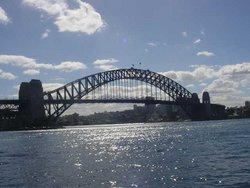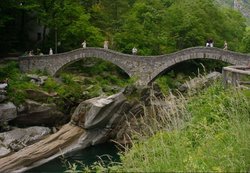Bridge
|
|
- This article is about the edifice. For other meanings, see Bridge (disambiguation).

A bridge is a structure built to span a gorge, valley, road, railroad track, river, body of water, or any other physical obstacle.
The purpose of a bridge is to allow passage of people, vehicles, trains or ships over an obstacle.
| Contents |
History
The first bridges were spans made of wooden logs or planks and eventually stones, using a simple support and crossbeam arrangement.
The arch was first used by the Roman Empire for bridges and aqueducts, some of which still stand today. The Romans also had cement, which reduced the variation of strength found in natural stone. Brick and mortar bridges were built after the Roman era, as the technology for cement was lost but it was refound.
During the 18th century, many innovations in the design of timber bridges by Hans Ulrich and Johannes Grubenmann and others.
With the rise of the Industrial Revolution in the 19th century, truss systems of wrought iron were developed for larger bridges, but iron did not have the tensile strength to support large loads. With the advent of steel, which has a high tensile strength, much larger bridges were built, many using the ideas of Gustave Eiffel.
Etymology
The Oxford English Dictionary traces the origin of the word bridge to an Old Norse word brygga, meaning "landing stage, gangway, or movable pier"..
Types of bridge
Bridges may be classified by their use or by the structure employed in their design.
By use
A bridge is usually designed for trains, pedestrian or road traffic, a pipeline or waterway for water transport or barge traffic. In some cases there may be restrictions in use. For example, it may be a bridge carrying a highway and forbidden for pedestrians and bicycles, or a pedestrian bridge, possibly also for bicycles
An aqueduct is a bridge that carries water, resembling a viaduct.
Decorative and ceremonial bridges
To create a beautiful image, some bridges are built much taller than necessary. This type, found in oriental gardens, is called a Moon Bridge, evoking a rising full moon.
Often in palaces a bridge will be built over an artificial waterway as symbolic of a passage to an important place or state of mind. A set of five bridges cross a sinuous waterway in an important courtyard of the Forbidden City in Beijing, China. The central bridge was reserved exclusively for the use of the Emperor, Empress, and their attendants.
Types of bridges
|
|
|
Notable bridges
- Akashi-Kaikyo Bridge - Japan, with the longest section span of 1.9 km.
- Brooklyn Bridge - USA.
- Confederation Bridge - Canada.
- Forth Bridge - Scotland.
- Forth Road Bridge - Scotland.
- Golden Gate Bridge - USA, arguably the most beautiful of its type.
- Ironbridge - England, first iron bridge.
- Mackinac Bridge - USA. Opened to traffic in 1957, connecting the two penninsulas of Michigan; held the title of the world's longest two tower suspension bridge between anchorages until the 90s.
- Menai Suspension Bridge - Wales, first road suspension bridge.
- Millau Viaduct - France, tallest bridge in the world.
- Oresund Bridge - connects Denmark and Sweden over the Oresund strait.
- Québec Bridge - Canada, largest cantilever bridge in the world.
- San Francisco-Oakland Bay Bridge - USA, especially for seismic retrofit and eastern span replacement.
- Severn Bridge - near Bristol, England.
- Sundial Bridge - USA, a dramatic single cantilever spar cable stayed span for pedestrians.
- Sunshine Skyway Bridge - in Tampa Bay, Florida.
- Sydney Harbour Bridge - Australia, arguably the best-known suspended-deck compression arch bridge
- Tacoma Narrows Bridge - USA, famous for its collapse due to aerodynamic effects.
- Tower Bridge - London, England, and a symbol of this city.
- Trajan's bridge - Romania, Roman bridge over the river Danube, only fragments visible.
- Vasco da Gama Bridge - Portugal, the longest bridge in Europe with 17.2 km.
- Victoria Falls Bridge - linking Zimbabwe to Zambia, built in 1905 as part of the projected Cape-Cairo railway.
See also
External links
- Structurae (http://www.structurae.de/en/) - International Database and Gallery of Structures.
- American Society of Civil Engineers (http://www.asce.org/history/hp_bridges.html) History and Heritage of Civil Engineering - Bridges
- Bridge Building — Art and Science (http://www.brantacan.co.uk/bridges.htm) Comprehensive explanations about bridges.
- Bridge Basics (http://pghbridges.com/basics.htm) A guide to bridge terminology and styles
- Shanghai lupu (http://www.chinapage.com/bridge/shanghai/lupu/lupu.html) Chinese bridge site showing suspended deck arch construction and completion.
- BridgeBuilder (http://www.bridgebuilder-game.com) - Great game where you design a bridge and see if a train will drive over it safely.
- Historic Bridges of Michigan and Elsewhere (http://pcnate.com/bridges/index.htm) Photos, information, and maps of historic bridges in and around Michigan. Also has a links page with links to bridge databases in other regions of the U.S.A.
- Bridge disasters (http://filebox.vt.edu/users/aschaeff/titlepage.html)bg:Мост
ca:Pont da:Bro (konstruktion) de:Brücke (Bauwerk) es:Puente eo:Ponto fr:Pont he:גשר (מבנה) ms:Jambatan nl:Brug (bouwwerk) ja:橋 nb:Bro nn:Bru pl:Most pt:Ponte (construção) ru:Мост sl:Most fi:Silta sv:Bro simple:Bridge zh:橋








